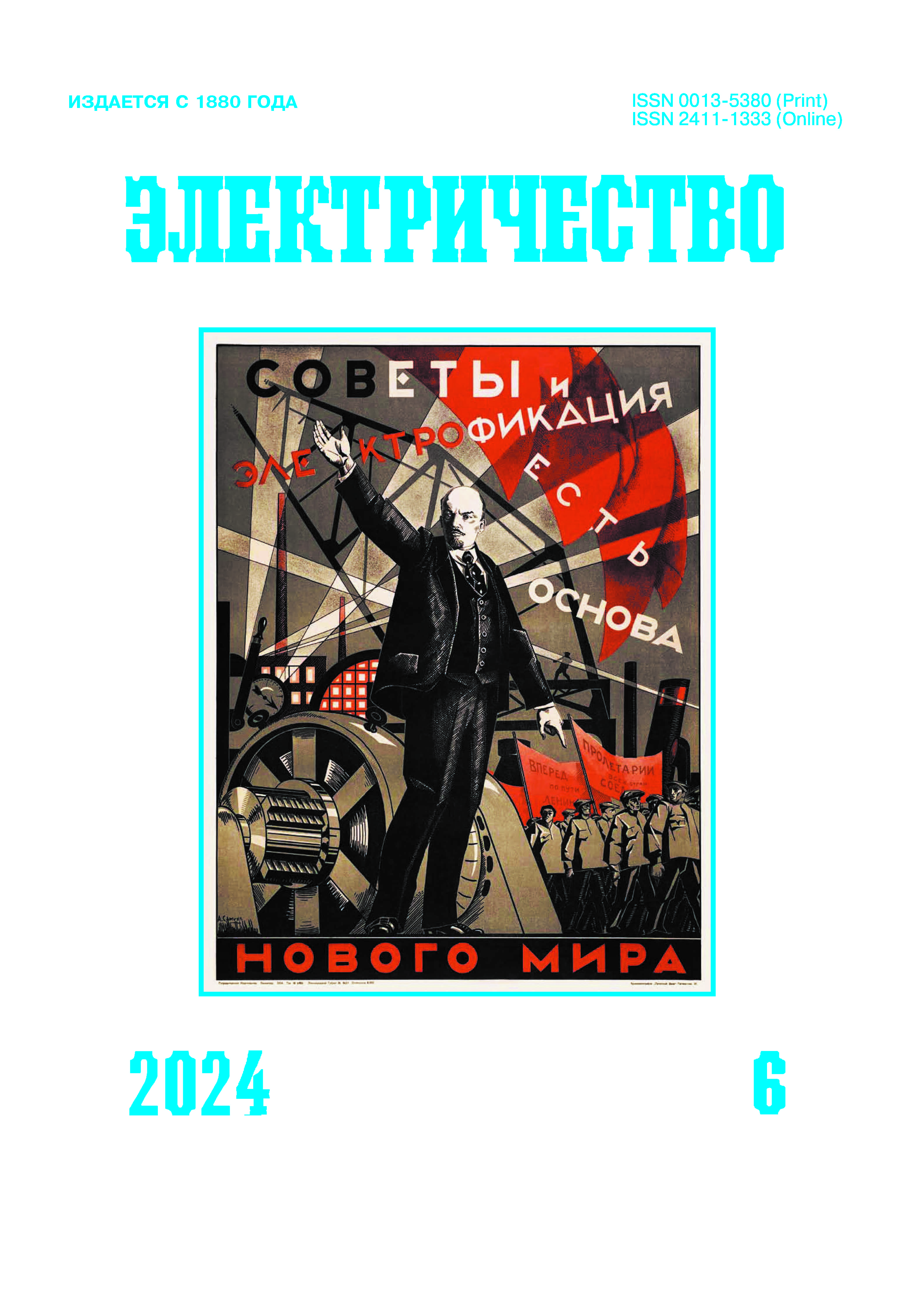Short-Term and Long-Term Electrical Strength of MV Fire-Resistant Cables
DOI:
https://doi.org/10.24160/0013-5380-2024-6-35-47Keywords:
fire-resistant medium voltage cable, mica tapes, cross-linked polyethylene, ethylene propylene rubber, partial discharges, life curve, aging, thermal stabilityAbstract
The insulation of fire–resistant medium voltage cables contains a layer made of mica tape and a layer of extruded dielectric, which may be cross-linked polyethylene or ethylene propylene rubber. The former is subject to electrical aging under the effect of partial discharges, and the latter to thermal aging. The article presents data on the short-term electrical strength of cables containing mica tapes of different thicknesses, the life curves of mica materials and cable layouts, as well as the results of tests carried out on the full-scale samples of cables developed by the authors for resistance to electrical, thermal and combined electrothermal aging. The thermal stability of a medium-voltage fire-resistant cable at the end of a one-year combined aging cycle has been analyzed. It is shown that the "residual" thermal stability margin is very significant.
References
2. Mouritz A.P., Gibson A.G. Fire Properties of Polymer Composite Materials. Dordrecht: Springer, 2006, 394 p.
3. Hull T.R., Kandola B.K. Fire Retardancy of Polymers: New Strategies and Mechanisms. Cambridge, UK: Royal Society of Chemistry (RSC), 2009, 433 p.
4. Wilkie C.A., Morgan A.B. Fire Retardancy of Polymeric Materials. Boca Raton, USA: Taylor & Francis, 2010, 823 p.
5. IEC 60243-1:2013. Electric Strength of Insulating Materials. Test Methods. Part 1: Tests at Power Frequencies, 2013, 53 p.
6. ГОСТ 6433.3-71. Материалы электроизоляционные твердые. Методы определения электрической прочности при переменном (частоты 50 Гц) и постоянном напряжении. М.: Издательство стандартов, 1994, 52 с.
7. Гук Д.А. и др. Сравнительный анализ электрических характеристик и стойкости к электрохимическому старению изоляционных систем кабелей среднего напряжения на основе этилпропиленовой резины и сшитого полиэтилена. – Кабели и провода, 2017, № 5(367), с. 4–10.
8. Пешков И.Б., Каменский М.К. Огнестойкие и не распространяющие горения кабели и провода. М.: ВИНИТИ, 1987, 92 с.
9. Булычёв Д.А. и др. К вопросу создания усовершенствованных огнестойких кабелей среднего напряжения и методов их испытаний. – Электричество, 2021, № 10, с. 11–21.
10. Куимов И.Е., Серебрянников С.В. Производство электроизоляционных материалов в России. – Электричество, 2022, № 10, с. 54–58.
11. Горшков П.Н. Основы техники кабелей сильного тока. Ч. 1. Л.: Ленинградский индустриальный институт, 1935, 269 с.
12. Грейсух М.А. и др. Бумажно-масляная изоляция в высоковольтных конструкциях. М.-Л.: Госэнергоиздат, 1963, 299 с.
13. Emanneli L. High Voltage Cable. London: Chapman and Hall Ltd, 1929, 107 p.
14. Dissado L.A., Fothergill J.C. Electrical Degradation and Breakdown in Polymers. London: Peter Pereqrinus Ltd, 1992, 601 p.
15. Койков С.Н., Цикин А.Н. Электрическое старение твердых диэлектриков. Л.: Энергия, 1966, 186 с.
16. Shuvalov M., Ovsienko V. Investigation of the Life Curve for High Voltage Cable Insulation. – 8th International Conference on Insulated Power Cables, 2011, vol. 2: E.7.2.4, pр. 651–653.
17. Ушаков В.Я. Изоляция установок высокого напряжения. М.: Энергоатомиздат, 1994, 496 с.
18. ГОСТ 34834-2022. Кабели силовые с экструдированной изоляцией на номинальное напряжение от 6 до 35 кВ включительно. Общие технические условия. М.: Российский институт стандартизации, 2022, 48 с.
19. Кучинский Г.С. Частичные разряды в высоковольтных конструкциях. Л.: Энергия, 1979, 224 с.
20. Крючков А.А. и др. Сравнительные исследования теплового старения пероксидно-сшиваемых полиэтиленов для изолирования кабелей среднего напряжения. – Кабели и провода, 2017, № 6 (368), с. 3–11.
#
1. Guk D.А. et al. Kabeli i provoda – in Russ. (Cables and Wires), 2023, No. 6, pp. 4–13.
2. Mouritz A.P., Gibson A.G. Fire Properties of Polymer Composite Materials. Dordrecht: Springer, 2006, 394 p.
3. Hull T.R., Kandola B.K. Fire Retardancy of Polymers: New Strategies and Mechanisms. Cambridge, UK: Royal Society of Chemistry (RSC), 2009, 433 p.
4. Wilkie C.A., Morgan A.B. Fire Retardancy of Polymeric Materials. Boca Raton, USA: Taylor & Francis, 2010, 823 p.
5. IEC 60243-1:2013. Electric Strength of Insulating Materials. Test Methods. Part 1: Tests at Power Frequencies, 2013, 53 p.
6. GОSТ 6433.3-71. Materialy elektroizolyatsionnye tverdye. Metody opredeleniya elektricheskoy prochnosti pri peremennom (chastoty 50 Gts) i postoyannom napryazhenii (Solid Electrical Insulating Materials. Methods for Evaluation of Electrical Strength at A.C. Voltage at Power (50 Hz) Frequency and D.C. Voltage). M.: Izdatel'stvo standartov, 1994, 52 p.
7. Guk D.А. et al. Kabeli i provoda – in Russ. (Cables and Wires), 2017, No. 5(367), pp. 4–10.
8. Peshkov I.B., Kamenskiy M.K. Ognestoykie i ne rasprostranya-yushchie goreniya kabeli i provoda (Fire-Resistant and Non-Spreading Gorenje Cables and Wires). М.: VINITI, 1987, 92 p.
9. Bulychyov D.А. et al. Elektrichestvo – in Russ. (Electricity), 2021, No. 10, pp. 11–21.
10. Kuimov I.E., Serebryannikov S.V. Elektrichestvo – in Russ. (Electricity), 2022, No. 10, pp. 54–58.
11. Gorshkov P.N. Osnovy tekhniki kabeley sil'nogo toka (Fundamentals of High Current Cable Technology). Part 1. L.: Leningradskiy industrial'nyy institut, 1935, 269 p.
12. Greysuh М.А. et al. Bumazhno-maslyanaya izolyatsiya v vysokovol'tnyh konstruktsiyah (Paper-Oil Insulation in High-Voltage Structures). M.-L.: Gosenergoizdat, 1963, 299 p.
13. Emanneli L. High Voltage Cable. London: Chapman and Hall Ltd, 1929, 107 p.
14. Dissado L.A., Fothergill J.C. Electrical Degradation and Breakdown in Polymers. London: Peter Pereqrinus Ltd, 1992, 601 p.
15. Koykov S.N., Tsikin A.N. Elektricheskoe starenie tverdyh dielektrikov (Electrical Aging of Solid Dielectrics). L.: Energiya, 1966, 186 p.
16. Shuvalov M., Ovsienko V. Investigation of the Life Curve for High Voltage Cable Insulation. – 8th International Conference on Insulated Power Cables, 2011, vol. 2: E.7.2.4, pр. 651–653.
17. Ushakov V.Ya. Izolyatsiya ustanovok vysokogo napryazheniya (Isolation of High Voltage Installations). M.: Energoatomizdat, 1994, 496 p.
18. GОSТ 34834-2022. Kabeli silovye s ekstrudirovannoy izolyatsiey na nominal'noe napryazhenie ot 6 do 35 kV vklyuchitel'no. Obshchie tekhnicheskie usloviya (Power Cables with Extruded Insulation for Rated Voltages from 6 up to and Including 35 kV. General Specifications). M.: Rossiyskiy institut standartizatsii, 2022, 48 p.
19. Kuchinskiy G.S. Chastichnye razryady v vysokovol'tnyh konstruktsiyah (Partial DIscharges in High-Voltage Structures). L.: Energiya, 1979, 224 p.
20. Kryuchkov А.А. et al. Kabeli i provoda – in Russ. (Cables and Wires), 2017, No. 6 (368), pp. 3–11




